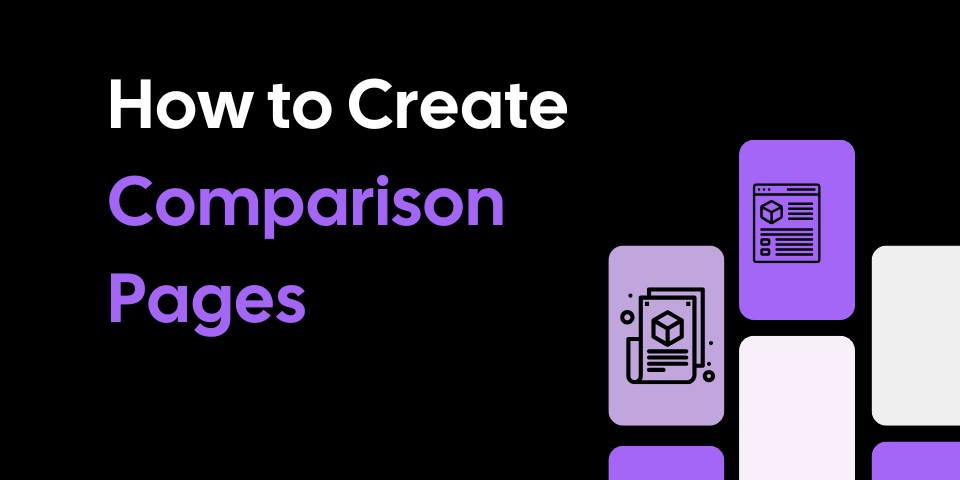
How to Create Comparison Pages that Help Customers Decide
A well-crafted comparison page offers clarity where it’s needed most. It connects your product’s features to real user problems, delivering information that matters without overloading readers. By focusing on relevance and transparency, these pages help users make decisions they feel confident about. This guide will show you how to build comparison pages that work—without unnecessary complexity.
The Purpose and Value of Comparison Pages
Comparison pages are practical tools that simplify decision-making.
Their purpose is to translate product differences into meaningful context for your audience. Instead of listing features in isolation, these pages should explain how specific differences solve real customer challenges.
Take, for example, someone evaluating two software tools. A simple feature list offers no clarity unless it addresses real-world needs. A more effective page shows why those features matter: “Tool A includes automated reporting, cutting hours of manual work every week.”
The real value of a comparison page lies in creating clarity. Customers who see their problems addressed feel confident about their decisions, which strengthens their trust in your brand. For a deeper dive into building trust, consider these strategies for trustworthy content.
What Makes a Comparison Page Effective?
Effective comparison pages work because they combine transparency, relevance, and structure. Each element serves a purpose, but their success depends on execution:
- Context-Driven Benefits: Features mean nothing in isolation. Frame them around the problems they solve to give readers a reason to care.
- Added Value: Use real-life examples to show how one option stands out, particularly in ways that resonate with customer needs.
- Honest Transparency: Highlight strengths and acknowledge limitations where necessary. Balanced comparisons build trust by showing readers you prioritize their needs.
The best comparison pages don’t overwhelm readers with irrelevant information or push a one-sided narrative. They simplify choices while maintaining credibility. Learn how structuring content with a library-like organization enhances clarity.
Helping Readers Decide
Overloading readers with information leads to decision fatigue. An effective comparison page avoids this by organizing information around what matters most.
Imagine comparing three subscription plans with ten features each. A table crammed with details is confusing and unhelpful. Instead, grouping comparisons by priorities—such as price, ease of use, or scalability—helps readers focus on what aligns with their goals.
Design plays a similar role. Use bold visuals, clean layouts, and expandable sections to guide attention. This approach lets readers quickly grasp key points and dive deeper only when needed. For tips on using structure to improve decisions, explore intentional link design.
Avoiding Common Missteps
Many comparison pages fail because they lack focus or come across as biased. Overloading with unnecessary details or skewing the presentation erodes trust and discourages engagement.
For example, if a page presents one product as overwhelmingly better, readers sense the bias and disengage. On the other hand, drowning readers in endless specifications without context leaves them confused and uninspired.
To avoid these mistakes:
Focus on relevance
Include only the details that directly impact decision-making.
Maintain fairness
Present pros and cons without exaggeration. Trust comes from balanced comparisons.
Use clear design
Highlight important information through hierarchy, ensuring the flow feels natural.
When these pitfalls are avoided, your comparison page stands out as a helpful resource, not another sales pitch. For actionable tips on building trust, explore how authenticity strengthens content.
Personalizing the Experience
Static comparison pages are functional, but dynamic ones elevate the experience by tailoring information to individual users.
Interactive tools like filters allow users to prioritize features—whether cost, speed, or compatibility—ensuring they only see what’s relevant to their needs. Similarly, AI-driven pages that adapt based on user behavior create a more personal and intuitive experience.
These personalized elements go beyond convenience. They demonstrate an understanding of the user’s needs, fostering trust and confidence that extends to your product. To learn more about tailored strategies, explore the benefits of customized content.
Conclusion
A successful comparison page simplifies decisions, balances clarity with depth, and earns trust through transparency. It should respect the reader’s time, highlight what matters, and guide them toward a choice they feel confident about.
For more on crafting impactful content, explore clarity and depth in writing.